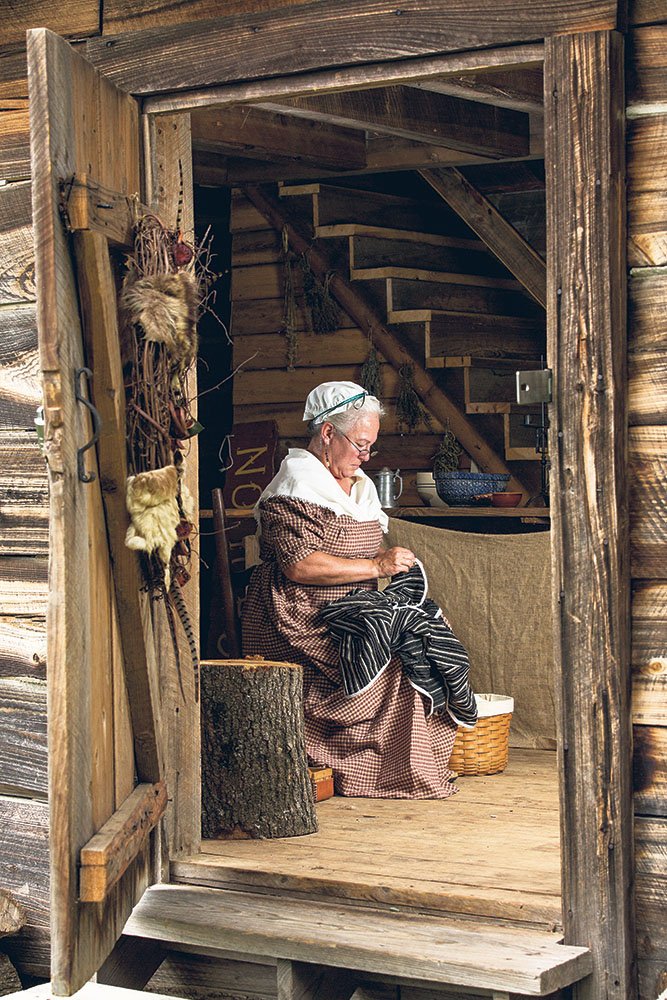Walking into the blockhouse at Cadron Settlement Park on any second Saturday of the month is like taking a step back in time.
Members of various living-history groups, such as Ree Walker of Damascus,
might be there to greet you, sewing in hand.
“Hello, I am Ms. Ree,” she might tell visitors. “I am making myself a new gown. I made the pattern for the gown, and I wove this light-colored trim that I am placing around all of the raw edges. I am working as quickly as I can before the daylight fades.”
Dressed in clothing appropriate for the late 1790s to early 1800s, Walker said it would be “period-correct” for the owner or manager of the blockhouse to live there with his family.
“The family would sleep upstairs,” she said, adding that historians know there was a blockhouse at this site “around 1809-1811.
“We don’t know for sure when it was built, but we do know that it burned twice and was rebuilt twice,” Walker said. “The current structure was built in the mid-1990s.”
She said the blockhouse was a “jack-of-all-trades” building. “At various times, it was an inn, a tavern, a trading post, a fortress and a post office,” she said, adding that the structure often served more than one purpose at the same time. “If early settlers were traveling the Arkansas River by boat, they might stop and eat at the blockhouse. If they spent the night, they would sleep on the floor.”
While “Ms. Ree” works on her sewing, others at the blockhouse might be eating or trading goods.
“Prior to the 1800s, the only visitors to the Cadron settlement would have been trappers, traders and Native Americans,” Walker said.
Lynita Langley-Ware of Greenbrier, director of the Faulkner County Museum and a member of the Faulkner County Historical Society, also takes part in living-history events at Cadron Settlement Park. She might be outside on the grounds, cooking, spinning thread or making dolls. Her 10-year-old daughter, Sophia, might be helping her cook or demonstrate her weaving abilities.
Langley-Ware said the earliest people in Arkansas were Native Americans, with the Osage, the Quapaw and the Caddo found in what is now The Natural State as early as the mid-1700s.
“But evidence of human activity dating back 10,000 years ago has been found at Cadron,” she said.
“It is the second oldest Euro-American settlement site in Arkansas, the first being Arkansas Post, which was established in 1686 in Arkansas County,” she said. “Our history here in Faulkner County is older than many of us realize. We need to take care of it.”
She said the French and Spanish were trading goods with each other and the Native Americans as early as 1764. But it wasn’t until the Louisiana Purchase in 1803 that settlers began to move westward, traveling through what was known in 1814 as the Cadron Creek settlement.
“There were about 40 to 50 families living at Cadron at that time,” Langley-Ware said. “In 1818, Cadron Town was platted, and the Cadron post office was established. At that time, Pulaski County was created, and Cadron was its county seat. In 1822, the county seat was moved to Little Rock. Cadron was also the county seat of Conway County from 1825 to 1828.
“But by the 1830s, the
population began to dwindle, and by 1834, the blockhouse was gone,” she said. “The Historical Society and volunteers built a replica of the blockhouse and dedicated it in 1973, but it burned in the early-1990s, only to be rebuilt a third time in the mid-1990s.
“The Historical Society is the driving force behind keeping the blockhouse here,” Langley-Ware said. “The city leases the park from the [U.S. Army] Corps of Engineers, and we look after the blockhouse.”
Cadron Settlement also was on the Trail of Tears and a stopping spot for the Butterfield Overland Mail Route. Interpretative signage about both events and markers are on display at the park. Both the Trail of Tears and the Butterfield Trail are part of the Arkansas Historic Trails System.
Second Saturday activities at Cadron Settlement begin at 10 a.m. and end at 2 p.m. The public is welcome during this time. The blockhouse is not open to the public except during this time, or for specifically scheduled tours, which may be arranged through the Faulkner County Museum.
Second Saturday activities on July 13 will feature Daniel Littlefield, director of the Sequoyah National Research Center at the University of Arkansas at Little Rock, and Tony Rose, assistant director of the center. They will speak at 9 a.m. on the Euro-American Settlement of Arkansas From the 1700s to Statehood.
For more information on Second Saturday activities at the blockhouse, call Langley-Ware at the Faulkner County Museum at (501) 328-5918.
Cadron Settlement Park is a National Historic Site. The park is west of Conway off U.S. 64 (Old Morrilton Highway) at 6200 Arkansas 319. The park features a boat-launching ramp, hiking trails, restrooms, picnic areas, a pavilion and handicapped trails and parking areas.
For more information on renting the pavilion, call Conway Parks and Recreation at (501) 450-6117.
